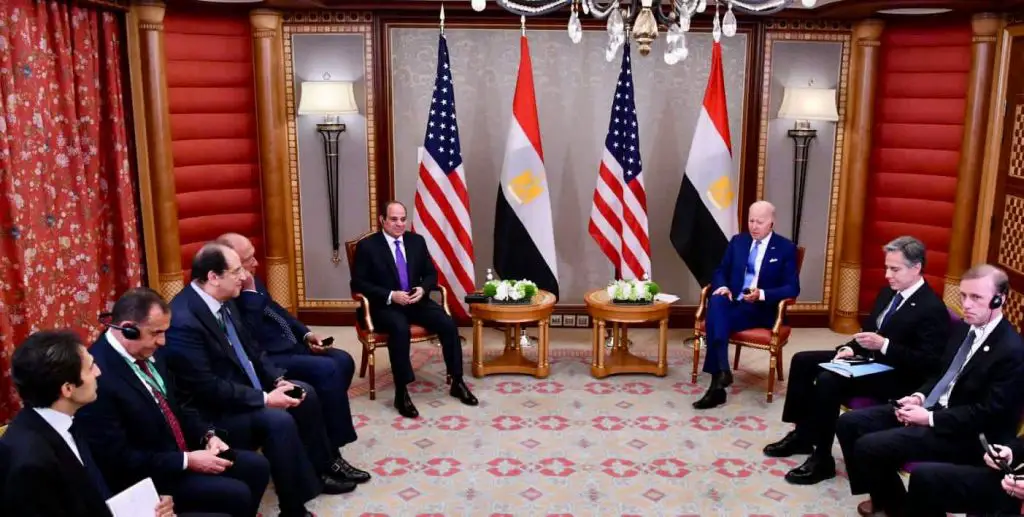- President Joe Biden has reaffirmed the United States’ support for Egypt’s water security
- The Nile provides Egypt with 90 per cent of its fresh water and is essential to the country’s agricultural and power generation systems
- In July of 2022, satellite photos revealed that Ethiopia has unilaterally begun the third filling of the massive Nile dam
In light of the fact that Ethiopia is getting ready to begin the third phase of filling the reservoir behind the Grand Ethiopian Renaissance Dam (GERD), the US is at it again.
President Joe Biden has reaffirmed the United States’ support for Egypt’s water security and for the formation of an agreement regarding the use of the waters of the Nile that will be in the interest of all parties involved.
According to the White House, President Joe Biden, in a joint statement with Egyptian President Sisi, reiterated “the importance of concluding the filling and functioning of the GERD as soon as possible, as outlined in the Statement of the President of the United Nations Security Council of September 15, 2021, and in accordance with international law.”
The statement noted “the imperative of concluding an agreement on the filling and operation of the GERD without further delay.”
GERD’s long-running argument
Egypt and Sudan, both of which are located further downstream on the Nile, on the one hand, and Ethiopia, which is located upstream on the Blue Nile, on the other, have been engaged in a protracted disagreement on the construction of the GERD.
The two former countries are dependent on the waters of the Nile, and they are afraid that the reservoir being filled behind the dam will reduce the amount of water available to them. The reservoir has a capacity of 74 cubic kilometres, which is equivalent to 1.6 years of the average flow of the Blue Nile.
The Nile provides Egypt with 90 per cent of its fresh water and is essential to the country’s agricultural and power generation systems.
It is estimated that the filling will take seven years to complete, with the first two stages already having been finished. According to statements made before the end of May by GERD project manager Kifle Horo, which Ahram Online reported, a third filling is scheduled to commence in the month of August.
The parties were unable to reach an agreement in the year 2020. Egypt emphasised that there should not be any dam filling without first getting a deal, bringing the matter to the United Nations Security Council. The council demanded that negotiations led by the African Union be resumed to reach a legally binding agreement.
Ethiopia wants to move forward with the project, which will double its electricity output to 16,000 GW and help provide power for the 44 per cent of Ethiopian households that already have access to electricity.
Egypt and Sudan are concerned about their water security, but Ethiopia wants to move forward with the project. Egypt presented their concerns to the United Nations Security Council in July 2021, shortly after the second time that Ethiopia’s Nile dam was used to store water.
The United Nations Security Council issued a presidential statement on the Great East River Dam (S/PRST/2021/18) on September 15, 2021. The statement calls for the resumption of negotiations on the Great East River Dam led by the African Union to reach a “binding agreement” regarding the dam’s filling and operation.
Following the approval of the resolution, the representative of India took the floor to make a statement, during which he stated that “as a general rule, transboundary water concerns do not belong to the competence of the United Nations Security Council.”
India emphasised that the wording does not establish a “precedent for the Council to interfere or adjudicate in any other transboundary water conflicts.” This point was made in response to India’s earlier statement.
Egypt announced in January 2022 that it is willing to resume negotiations at any time.
In July of 2022, satellite photos reveal that Ethiopia has begun the third filling of the massive Nile dam.
Ethiopia begins operating the GERD
The dam was officially opened on February 21 by Ethiopia’s Prime Minister Abiy Ahmed, and on that same day, a turbine with a capacity of 375 megawatts began producing electricity. The capital city of Addis Ababa asserts that not just Ethiopia but also the surrounding areas will profit from the electricity that the dam will generate. The construction of Ethiopia’s Blue Nile Dam does not have to contribute to the region’s instability.
The Nile, one of the world’s longest rivers at around 3,700 miles (6,000 kilometres), is a key source of electricity and water for dozens of East African nations.
Egypt, which obtains over 97 per cent of its drinking water and irrigation from the Nile, views the construction as an existential threat.
Sudan thinks that the project will control annual flooding, but concerned that its dams will be damaged if the Ethiopian operation is not approved. The 145-meter (475-foot) mega-dam, construction of which began in 2011, has a volume of 74 billion cubic metres.
